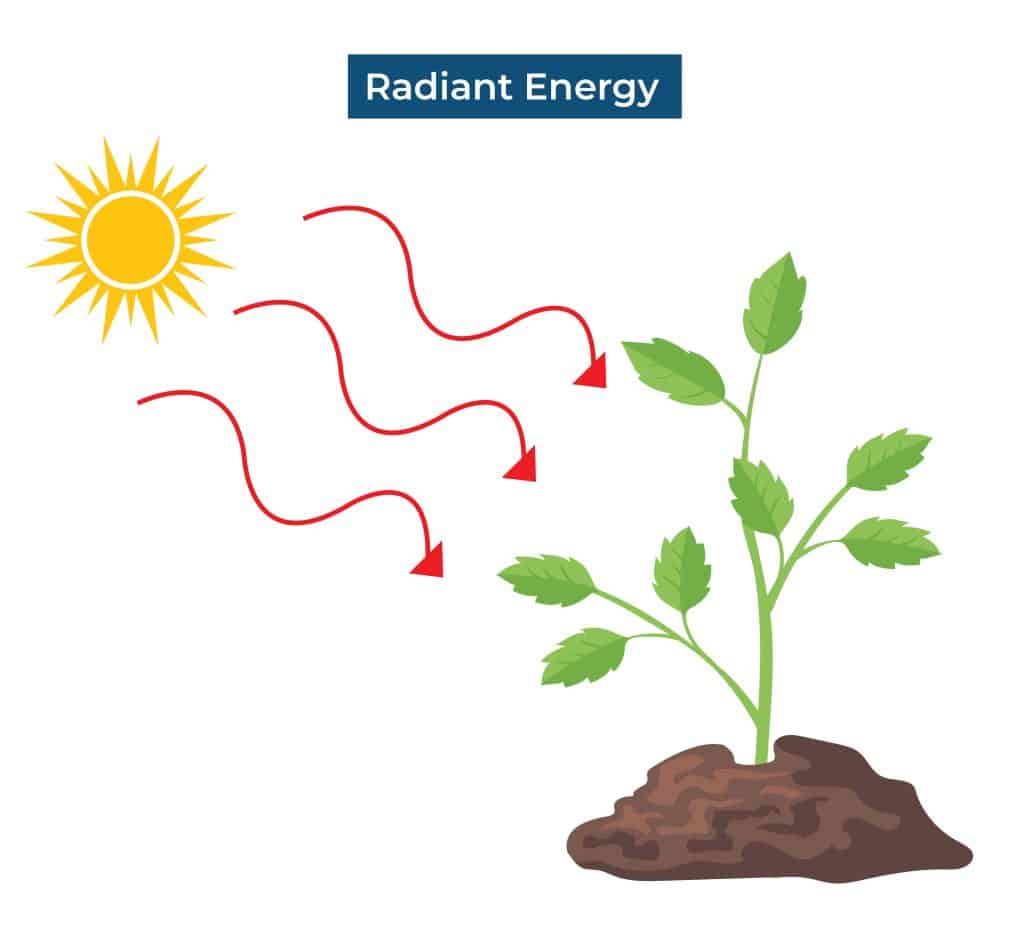Radiant Energy
Grade 6 Science Worksheets
Radiant energy is energy that travels through space in the form of electromagnetic waves, such as light, radio waves, microwaves, X-rays, and gamma rays. Radiant energy is also sometimes called electromagnetic radiation.
Table of Contents:
- Radiant Energy
- Stefan’s Constant
- Types of Radiant Energy
- How does Radiant Energy work?
- How is Radiant Energy converted to Thermal Energy?
Radiant Energy - Grade 6 Science Worksheet PDF
This is a free printable / downloadable PDF worksheet with practice problems and answers. You can also work on it online.
|
|
Untimed |
|
Sign up with your email ID to access this free worksheet.
"We really love eTutorWorld!"
"We really love etutorworld!. Anand S and Pooja are excellent math teachers and are quick to respond with requests to tutor on any math topic!" - Kieran Y (via TrustSpot.io)
"My daughter gets distracted easily"
"My daughter gets distracted very easily and Ms. Medini and other teachers were patient with her and redirected her back to the courses.
With the help of Etutorworld, my daughter has been now selected in the Gifted and Talented Program for the school district"
- Nivea Sharma (via TrustSpot.io)
What is Radiant Energy?
Radiant energy is energy that travels through space in the form of electromagnetic waves, such as light, radio waves, microwaves, X-rays, and gamma rays. Radiant energy is also sometimes called electromagnetic radiation.

Thermal energy, on the other hand, is the energy associated with the motion of particles in a substance, such as atoms and molecules. This motion generates heat and is the source of thermal energy.
The main difference between radiant energy and thermal energy is that radiant energy is transmitted through space without the need for a physical medium, while thermal energy requires a medium such as a solid, liquid, or gas to transfer heat. Radiant energy can also be converted to thermal energy when it is absorbed by matter, causing its temperature to increase.
Radiant energy and thermal energy are related to each other in that they are both forms of energy and can be converted from one form to the other. For example, when sunlight (radiant energy) is absorbed by a surface, it is converted into thermal energy, which can be felt as heat. Conversely, when a hot object emits thermal radiation, it is giving off radiant energy that can be detected with instruments like thermographic cameras.
Stefan’s Constant
Stefan’s constant, also known as the Stefan-Boltzmann constant, is a fundamental constant of physics that describes the relationship between the temperature and the radiation emitted by a black body. It is denoted by the symbol σ and has a value of approximately 5.67 x 10^-8 watts per square meter per Kelvin to the fourth power (W/m^2K^4).
Stefan’s constant is used in the Stefan-Boltzmann law, which states that the total energy radiated per unit surface area by a black body is proportional to the fourth power of its absolute temperature. This law is important in the study of thermodynamics and is used in many fields, including astronomy, atmospheric science, and materials science.
Stefan’s constant can be derived from Planck’s law, which describes the spectral energy density of electromagnetic radiation emitted by a black body at a given temperature. The constant is named after the Austrian physicist Josef Stefan, who first derived an empirical relationship between the total radiation emitted by a black body and its temperature in the late 19th century. The constant was later refined by the Austrian physicist Ludwig Boltzmann, who developed the theory behind the constant and derived a more accurate value for it.
Types of Radiant Energy
There are many different types of radiant energy, which are classified based on their wavelength or frequency. Here are some of the main types of radiant energy:
1. Radio waves: These are the longest wavelength and lowest frequency electromagnetic waves, used for communication in technologies like radios, televisions, and cell phones.
2. Microwaves: These are a higher frequency than radio waves and are used for communication (such as in Wi-Fi and microwave ovens), as well as for scientific research and observations.
3. Infrared radiation: This is the energy that we feel as heat and is responsible for the warmth we feel from the sun or a fire. It is also used in a variety of applications, including remote sensing, thermal imaging, and communication.
4. Visible light: This is the range of electromagnetic radiation that can be seen by the human eye, and it is responsible for the colors we see in the world around us.
5. Ultraviolet radiation: This is the energy that causes sunburns and skin damage, but it is also used for scientific research, water purification, and sterilization.
6. X-rays: These are high-energy electromagnetic waves that can penetrate solid objects, and they are used for medical imaging, as well as in scientific research and materials analysis.
7. Gamma rays: These are the highest-energy electromagnetic waves and are produced by nuclear reactions and other high-energy events. They are used in medical imaging and cancer treatment, as well as in scientific research.
Overall, the different types of radiant energy have a wide range of applications in science, technology, medicine, and many other fields.
How does Radiant Energy work?
Radiant energy works by the transmission of electromagnetic waves. Electromagnetic waves are a form of energy that travels through space and matter at the speed of light, which is approximately 299,792,458 meters per second.
Radiant energy is produced by any object that has a temperature above absolute zero, including the Sun, light bulbs, and even the human body. As the temperature of an object increases, it emits electromagnetic waves of various wavelengths and frequencies, ranging from radio waves to X-rays and gamma rays.
When these waves encounter a surface, they can be absorbed, transmitted, or reflected, depending on the properties of the surface and the wavelength of the waves. For example, visible light waves are absorbed by dark surfaces and reflected by light surfaces, while ultraviolet light waves can be absorbed by certain materials such as fabrics and plastics.
Radiant energy has many practical applications, such as in solar power systems, where sunlight is converted into electricity, and in medical imaging, where X-rays and other forms of radiant energy are used to create images of the body’s internal structures.
Overall, radiant energy is an important form of energy that plays a fundamental role in our understanding of the physical world and in many practical applications in our daily lives.
“There have been times when we booked them last minute, but the teachers have been extremely well-prepared and the help desk at etutorworld is very prompt.
Our kid is doing much better with a higher score.”
6th Grade Tutoring
eTutorWorld offers Personalized Online Tutoring for Math, Science, English, and Standardised Tests.
Our Tutoring Packs start at just under $22.49 per hour, and come with a moneyback guarantee.
Schedule a FREE Trial Session, and experience quality tutoring for yourself. (No credit card required.)
How is Radiant Energy converted to Thermal Energy?
Radiant energy can be converted to thermal energy when it is absorbed by matter. When electromagnetic waves are absorbed by an object, the energy of the waves is transferred to the object’s atoms and molecules, causing them to move and vibrate more rapidly. This increased motion of the particles results in an increase in the object’s temperature and the generation of thermal energy.
For example, when sunlight (radiant energy) falls on a surface, such as a roof, the surface absorbs some of the energy, causing its temperature to increase. The absorbed energy is converted into thermal energy, which can be felt as heat. Similarly, when you stand in front of a fire, the heat you feel is the result of radiant energy emitted by the fire being absorbed by your body and converted into thermal energy.
The amount of radiant energy that is converted to thermal energy depends on various factors, such as the material’s properties, the intensity and wavelength of the radiation, and the object’s surface area and temperature. The conversion of radiant energy to thermal energy is an essential process in many applications, including solar power systems.
Do You Stack Up Against the Best?
If you have 30 minutes, try our free diagnostics test and assess your skills.

Kathleen Currence is one of the founders of eTutorWorld. Previously a middle school principal in Kansas City School District, she has an MA in Education from the University of Dayton, Ohio. She is a prolific writer, and likes to explain Science topics in student-friendly language. LinkedIn Profile
Affordable Tutoring Now Starts at Just $22.49
eTutorWorld offers affordable one-on-one live tutoring over the web for Grades K-12. We are also a leading provider of Test Prep help for Standardized Tests (SCAT, CogAT, MAP, SSAT, SAT, ACT, ISEE, and AP).
What makes eTutorWorld stand apart are: flexibility in lesson scheduling, quality of hand-picked tutors, assignment of tutors based on academic counseling and diagnostic tests of each student, and our 100% money-back guarantee.
Whether you have never tried personalized online tutoring before or are looking for better tutors and flexibility at an affordable price point, schedule a FREE TRIAL Session with us today.
*There is no purchase obligation or credit card requirement
Grade 6 Science Worksheets
- Inquiry process
- Nature of Science
- Scientific Inquiry
- Inquiry, Analysis and Problem Solving
- Ethical Practices
- Science and Society
- Biotic and Abiotic Factors
- Impact of Organisms
- Adaptation
- Spheres of Earth
- Natural Resources
- Environmental Issues
- Conservation of Earth
- Understanding Technology
- Abilities To Do Technological Design
- Structure of Earth
- Solar System
- Rocks and Fossils
- Earth Systems
- Plate Tectonics
- Evolution
- Magnetic Field of Earth
- Geologic Time
- Materials and Processes That Shape a Planet
- Astronomy
- Ecology
- Energy
- Kinetic and Potential Energy
- Energy Transfer
- Matter and its Structure
- States of Matter
- Physical and Chemical Changes
- Force and Motion
- Electricity and Magnetism
- Wave Interactions
- Sound
- Light
- Introduction to Life Science
- The Origin & History of Life On Earth
- Plant and Animal Cells
- Parts of a Cell
- The Cell Cycle
- How Living Organisms Get Energy
- Classification of Organisms
- How Plants Grow & Reproduce
- The Human Respiratory System
- The Human Cardiovascular System
- The Human Digestive System
- The Human Endocrine Systems
- The Human Nervous System
- The Human Muscular System
- The Human Skeletal System
IN THE NEWS

Our mission is to provide high quality online tutoring services, using state of the art Internet technology, to school students worldwide.
Online test prep and practice
SCAT
SSAT
ISEE
PSAT
SAT
ACT
AP Exam
Science Tutoring
Physics Tutoring
Chemistry Tutoring
Biology Tutoring
Math Tutoring
Pre-Algebra Tutoring
Algebra Tutoring
Pre Calculus Tutoring
Calculus Tutoring
Geometry Tutoring
Trigonometry Tutoring
Statistics Tutoring
Quick links
Free Worksheets
Fact sheet
Sales Partner Opportunities
Parents
Passive Fundraising
Virtual Fundraising
Our Expert Tutors
Safe and Secure Tutoring
Interactive Online Tutoring
After School Tutoring
Elementary School Tutoring
Middle School Tutoring
High School Tutoring
Home Work Help
Math Tutors New York City
Press
©2022 eTutorWorld Terms of use Privacy Policy Site by Little Red Bird
©2022 eTutorWorld
Terms of use
Privacy Policy
Site by Little Red Bird










